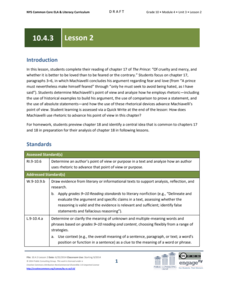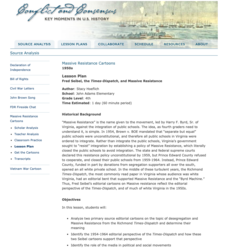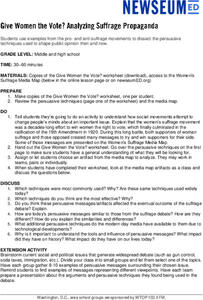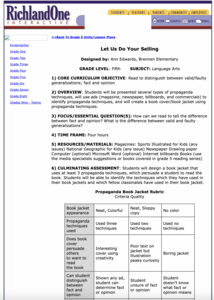National Endowment for the Humanities
Lesson 2 James Madison: The Second National Bank—Powers Not Specified in the Constitution
How much power is too much power for the federal government? Scholars use primary documents and constitutional research in groups to analyze the creation of the Second National Bank under James Madison. This is the second instructional...
New York State Education Department
English Language Arts Examination: January 2016
An English Language Arts exam contains 24 multiple-choice questions that individuals answer after reading informational and literary passages. Scholars then write a source-based argument and text-analysis response.
National WWII Museum
Evaluating the US Decision to Drop the Atomic Bombs
While the use of the atomic bomb was the definitive end of World War II, the terrible weapons left new questions. Young scholars use primary sources and analytical worksheets to consider the implications of the fateful decision. Then,...
Curated OER
The Question of Annexation
Middle schoolers examine the sequence of events that led up to the annexation of Texas to the United States. They create a timeline of significant events, analyze primary source letters from this time period, and write a letter from the...
Curated OER
Student Opinion: What Teacher Do You Appreciate?
This online resource is composed of a writing sample about teacher appreciation and a writing prompt for learners. You could use this as an in-class journal activity or you could have class members post their responses on the New...
Professional Development Institute
Which Is More Important?
Think about the roles of hunters and squaws in Elizabeth George Speare's The Sign of the Beaver. Whose work is more important? Young writers compare Attean and Matt's reaction to each gender's role, as well as arguing their opinion...
EngageNY
Grade 9 ELA Module 4, Unit 1, Lesson 12
Anna McMullen's opinion piece "Bangladesh Factory Collapse: Who Really Pays for our Cheap Clothes?" offers readers another opportunity to examine how writers craft and support their arguments. After reading McMullen's article, class...
Deliberating in a Democracy
Recycling
How often have you passed by a recycling container in your school? Scholars research the issue of recycling in the ever-changing global world. Using documentation and video evidence, they form their own opinions on recycling and how it...
ProCon
Police Body Cameras
Should police officers wear body cameras? Scholars consider the question as they use the resource to conduct independent research about the debate topic. They read a brief background and peruse the main pros and cons about the issue....
EngageNY
Grade 10 ELA Module 4: Unit 3, Lesson 2
How do rhetorical devices advance an author's point of view? Scholars consider this question as they continue exploring Machiavelli's The Prince. They work in small groups, annotating the text for evidence of rhetoric before engaging in...
Roy Rosenzweig Center for History and New Media
Fred Seibel, the Times-Dispatch, and Massive Resistance
A lesson challenges scholars to analyze editorial cartoons created by Fred Seibel, illustrator for the Times-Dispatch, during the Massive Resistance. A class discussion looking at today's editorial pages and Jim Crow Laws leads the...
K20 LEARN
Government and Your Right To Vote: Voting Rights In America
Gaining voting rights was difficult over the course of decades, but the debate over who should actually be allowed to cast a ballot remains. Scholars explore the history of the struggle, including the fifteenth and nineteenth amendments,...
K20 LEARN
Manifest Destiny: U.S. Territorial Expansion
A close examination of John Gast's painting "American Progress" launches a study of the concept of Manifest Destiny used to justify United States' policy of westward expansion. Young historians read statements from persons with different...
K12 Reader
My Trip in a Time Machine
What would happen if you took a trip in a time machine? Have kids craft narratives about a trip to the past or the future. The prompt includes questions to consider in the writing, as well as lines for kids to jot down ideas on or use to...
Newseum
Give Women the Vote? Analyzing Suffrage Propaganda
Propaganda is often used to shape public opinion. Scholars investigate the persuasive techniques used by the pro- and anti-suffrage movements. Groups compare how these devices were used during the suffrage movement with how the same...
Curated OER
Study Skills- Fact and Opinion
Students engage in a variety of activities in order to achieve the objectives of a layered curriculum unit. They take notes on the differences between fact and opinion. Students also use a newspaper in order to recognize opinionated...
Curated OER
Just the Facts, Jack
Third graders listen to music and discuss their responses to different styles separating their comments into facts and opinions. They evaluate a worksheet of statements by classifying the statements into fact and opinion.
Curated OER
Let Us Do Your Selling
Sixth graders analyze several types of propaganda techniques and create a book cover using the techniques. In this propaganda techniques lesson, 6th graders analyze the propaganda techniques used in various ads. Students analyze the...
Curated OER
America Attacked: 9/11
In this America Attacked: 9/11 worksheet, students read the book America Attacked: 9/11 and complete fact and opinion, character detail, and short answer question activities. Students complete 26 questions.
Curated OER
Slumdog Millionaire
In this Slumdog Millionaire worksheet, students read the book Slumdog Millionaire and complete fact and opinion, character detail, and short answer question activities. Students complete 26 questions.
Curated OER
Whose Neighborhood is It? Whose America is This?
Pupils use electronic resources to study immigration issues, analyze immigration issues dealing with security, economics, lawfulness, culture, and human rights, and discuss possible solutions. Students then express their opinions by...
Pennsylvania Department of Education
Analyzing Key Ideas and Details in Nonfiction
Students explore nonfiction texts. In this language arts lesson, students read a nonfiction text and make predictions. Students identify facts and opinions in the text and draw conclusions as they read.
Curated OER
Poll-icy Perceptions
Young scholars create their own opinion polls about local policy issues. They evaluate how anonymity may affect responses. In groups, students experience the process of developing polls, focusing on student-related topics. Young scholars...
Curated OER
A Birthday Mystery: comprehension skills
In this comprehension skills instructional activity, students read the book A Birthday Mystery and complete comprehension activities. Students complete activities such as main idea, opinions, details, and drawing conclusions.























